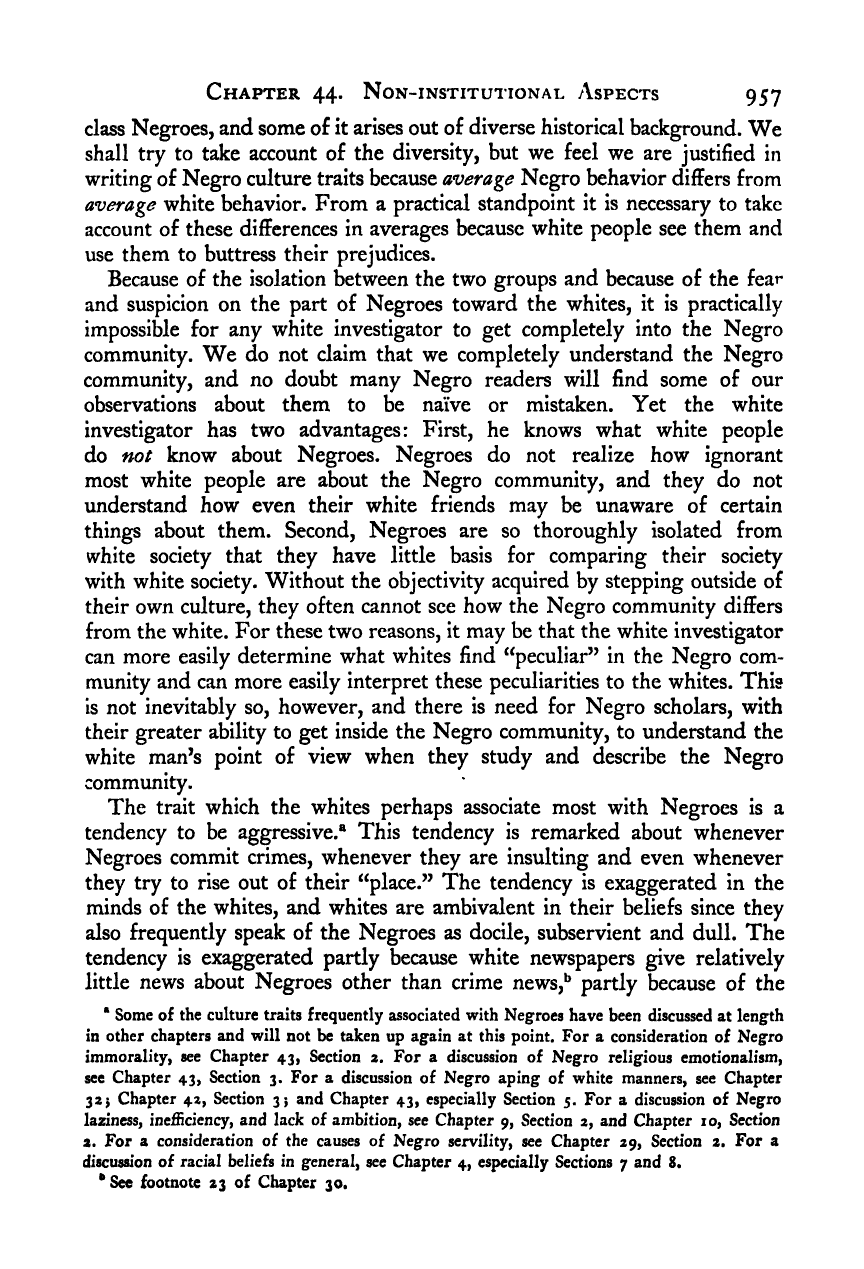Note: Gunnar Myrdal died in 1987, less than 70 years ago. Therefore, this work is protected by copyright, restricting your legal rights to reproduce it. However, you are welcome to view it on screen, as you do now. Read more about copyright.
Full resolution (TIFF) - On this page / på denna sida - X. The Negro Community - 44. Non-Institutional Aspects of the Negro Community - 1. “Peculiarities” of Negro Culture and Personality

<< prev. page << föreg. sida << >> nästa sida >> next page >>
Below is the raw OCR text
from the above scanned image.
Do you see an error? Proofread the page now!
Här nedan syns maskintolkade texten från faksimilbilden ovan.
Ser du något fel? Korrekturläs sidan nu!
This page has never been proofread. / Denna sida har aldrig korrekturlästs.
Chapter 44. Non-institutional Aspects 957
class Negroes, and some of it arises out of diverse historical background. We
shall try to take account of the diversity, but we feel we are justified in
writing of Negro culture traits because average Negro behavior differs from
average white behavior. From a practical standpoint it is necessary to take
account of these differences in averages because white people see them and
use them to buttress their prejudices.
Because of the isolation between the two groups and because of the fear
and suspicion on the part of Negroes toward the whites, it is practically
impossible for any white investigator to get completely into the Negro
community. We do not claim that we completely understand the Negro
community, and no doubt many Negro readers will find some of our
observations about them to be naive or mistaken. Yet the white
investigator has two advantages: First, he knows what white people
do not know about Negroes. Negroes do not realize how ignorant
most white people are about the Negro community, and they do not
understand how even their white friends may be unaware of certain
things about them. Second, Negroes are so thoroughly isolated from
white society that they have little basis for comparing their society
with white society. Without the objectivity acquired by stepping outside of
their own culture, they often cannot see how the Negro community differs
from the white. For these two reasons, it may be that the white investigator
can more easily determine what whites find ‘^peculiar” in the Negro com-
munity and can more easily interpret these peculiarities to the whites. This
is not inevitably so, however, and there is need for Negro scholars, with
their greater ability to get inside the Negro community, to understand the
white man’s point of view when they study and describe the Negro
community.
The trait which the whites perhaps associate most with Negroes is a
tendency to be aggressive.® This tendency is remarked about whenever
Negroes commit crimes, whenever they are insulting and even whenever
they try to rise out of their “place.” The tendency is exaggerated in the
minds of the whites, and whites are ambivalent in their beliefs since they
also frequently speak of the Negroes as docile, subservient and dull. The
tendency is exaggerated partly because white newspapers give relatively
little news about Negroes other than crime news,** partly because of the
* Some of the culture traits frequently associated with Negroes have been discussed at length
in other chapters and will not be taken up again at this point. For a consideration of Negro
immorality, see Chapter 43, Section 2. For a discussion of Negro religious emotionalism,
see Chapter 43, Section 3. For a discussion of Negro aping of white manners, see Chapter
32 j
Chapter 42, Section 35 and Chapter 43, especially Section 5. For a discussion of Negro
laziness, inefficiency, and lack of ambition, see Chapter 9, Section 2, and Chapter 10, Section
2. For a consideration of the causes of Negro servility, see Chapter 29, Section 2. For a
discussion of racial beliefs in general, see Chapter 4, especially Sections 7 and 8.
® See footnote 23 of Chapter 30.
<< prev. page << föreg. sida << >> nästa sida >> next page >>